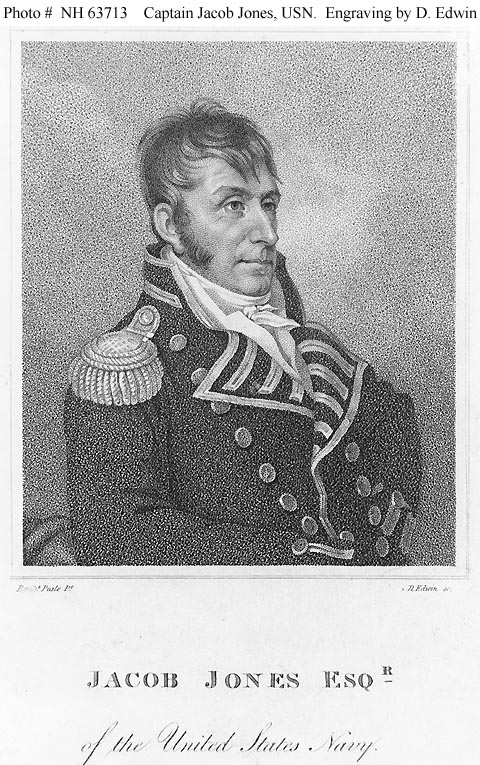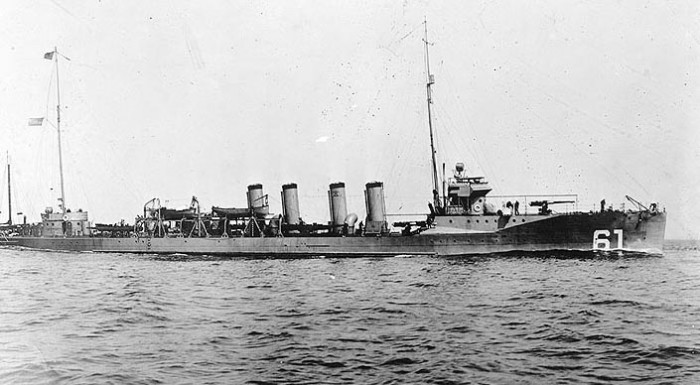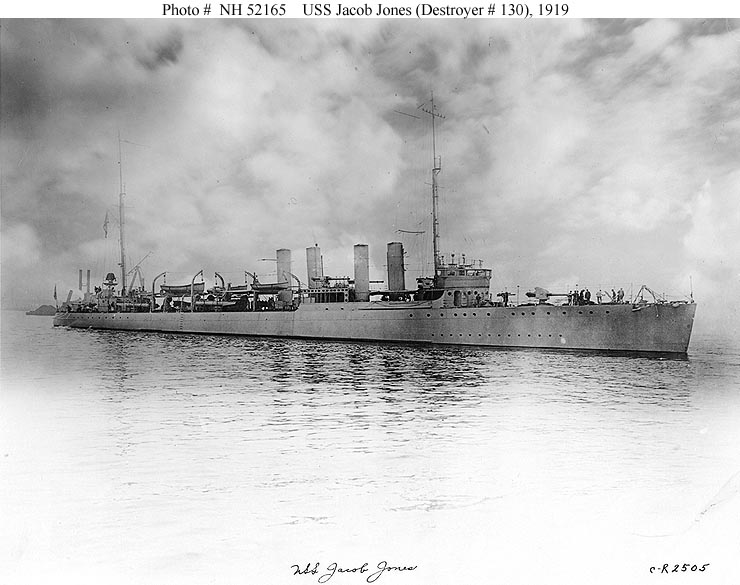F1C, USS Jacob Jones (DD-130), World War II
Beloved son of Fred & Alta Bettenga Stubbe
Fireman, First Class, Harris Blake Stubbe, lost his life while bravely serving in the Navy during World War II. He met his death on 28 Feb 1942, in the service of our country, and his body lies missing in the waters of the Atlantic.
The U.S. Navy photo (at top right) shows his destroyer, the USS Jacob Jones (DD-130), which was torpedoed and sunk 25 miles off Cape May, New Jersey, on Feb. 28, 1942, killing 131 of 142 men aboard [or 138 of 149]. The destroyer's name honors Commodore Jacob Jones, USN, (1768-1850).
The Tragedy
Stubbe and his destroyer, the USS Jacob Jones, steamed out of New York Harbor on Feb. 27, 1942, to patrol the New Jersey coastline. German U-boat attacks were an increasing menace off the American coast.
Almost immediately, the crew was dispatched to the scene of smoke and flames from the torpedoed oil tanker R.P. Resor about 5 miles off Manasquan Inlet. Finding no survivors, the destroyer continued its patrol that night, having no idea they were being stalked by the same German U-boat that sank the tanker.
At dawn on the freezing morning of Feb 28, 1942, German submarine U-578 fired torpedoes at the Jacob Jones, striking it at least twice. The first torpedo hit the ship's starboard bow, causing its store of armaments to explode. The entire front of the ship was blown apart. A second torpedo struck the ship's aft. The destroyer was sinking fast.
About 30 survivors cut loose some rafts and jumped into the ice-cold water. As the ship sank, the destroyer's anti-submarine depth charges detonated, killing more survivors on the surface.
The men were on the open ocean for hours before a search plane arrived. Many succumbed to hypothermia and frostbite. An hour later, a rescue ship plucked 12 survivors from the rafts. One died en route to safe harbor in Cape May, bringing the total to 11 survivors and 131 dead [or 11 survivors and 138 dead].
This account is a short summary of "Sunken WWII destroyer off Cape May holds family's fascination and its fate," by Michael Miller, Staff Writer for Press of Atlantic City (July 22, 2011). His sources: Survivor, retired U.S. Navy Master Chief Joseph Tidwell, 91, and accounts in the Naval Historical Center.(http://www.history.navy.mil/)
Another source, (http://uboat.net/allies/merchants/ships/1386.html) reports 138 dead, 11 survivors.
Note:
Harris Stubbe's destroyer was not the first US Naval vessel named in honor of Commodore Jacob Jones, USN, (1768-1850). During WWI, the USS Jacob Jones (#61), was torpedoed and sank, becoming the first ever United States destroyer sank by enemy action. (see bottom photo)
After her February 1916 commissioning, Jacob Jones (#61)conducted patrols off the New England coast. After the United States entered World War I in April 1917, Jacob Jones was sent overseas. Patrolling the Irish Sea out of Queenstown, Ireland, Jacob Jones rescued the survivors of several ships, notably picking up over 300 from the sunken Armed merchant cruiser Orama.
On 6 December, 1917, Jacob Jones (#61) was steaming independently from Brest, France, for Queenstown, when she was torpedoed and damaged by German submarine U-53 and was scuttled with the loss of 66 officers and men. Jacob Jones sank in eight minutes without issuing a distress call; the German submarine commander, Kapitänleutnant Hans Rose, after taking two badly injured Jacob Jones crewmen aboard his submarine, radioed the American base at Queenstown with the coordinates for the survivors.
Honoring Harris Blake Stubbe
Harris Blake Stubbe's name is inscribed on the Tablets of the Missing at The World War II East Coast Memorial, which is located in Battery Park in New York City at the southern end of Manhattan Island. He was awarded the Purple Heart.
His name is also recorded in the U. S. Navy Book, "Combat Connected Naval Casualties, World War II, By States, 1946, U.S. Navy- Marine Corps- Coast Guard, Volume 1, Alabama through Missouri," in the chapter, "State Summary of War Casualties, Iowa, " on page 17 of Iowa dead: Name: Harris Blake Stubbe; Father: Fred A Stubbe, of George [George, Lyon Co., Iowa].
Birth Certificate
Iowa Birth Index
Name: Harris Blake Stubbe
Birth Date: 25 Dec 1919
Birth Place: George, Lyon, Iowa, US
Father's Name: Fred A Stubbe
Mother's Name: Alta Bettinga
F1C, USS Jacob Jones (DD-130), World War II
Beloved son of Fred & Alta Bettenga Stubbe
Fireman, First Class, Harris Blake Stubbe, lost his life while bravely serving in the Navy during World War II. He met his death on 28 Feb 1942, in the service of our country, and his body lies missing in the waters of the Atlantic.
The U.S. Navy photo (at top right) shows his destroyer, the USS Jacob Jones (DD-130), which was torpedoed and sunk 25 miles off Cape May, New Jersey, on Feb. 28, 1942, killing 131 of 142 men aboard [or 138 of 149]. The destroyer's name honors Commodore Jacob Jones, USN, (1768-1850).
The Tragedy
Stubbe and his destroyer, the USS Jacob Jones, steamed out of New York Harbor on Feb. 27, 1942, to patrol the New Jersey coastline. German U-boat attacks were an increasing menace off the American coast.
Almost immediately, the crew was dispatched to the scene of smoke and flames from the torpedoed oil tanker R.P. Resor about 5 miles off Manasquan Inlet. Finding no survivors, the destroyer continued its patrol that night, having no idea they were being stalked by the same German U-boat that sank the tanker.
At dawn on the freezing morning of Feb 28, 1942, German submarine U-578 fired torpedoes at the Jacob Jones, striking it at least twice. The first torpedo hit the ship's starboard bow, causing its store of armaments to explode. The entire front of the ship was blown apart. A second torpedo struck the ship's aft. The destroyer was sinking fast.
About 30 survivors cut loose some rafts and jumped into the ice-cold water. As the ship sank, the destroyer's anti-submarine depth charges detonated, killing more survivors on the surface.
The men were on the open ocean for hours before a search plane arrived. Many succumbed to hypothermia and frostbite. An hour later, a rescue ship plucked 12 survivors from the rafts. One died en route to safe harbor in Cape May, bringing the total to 11 survivors and 131 dead [or 11 survivors and 138 dead].
This account is a short summary of "Sunken WWII destroyer off Cape May holds family's fascination and its fate," by Michael Miller, Staff Writer for Press of Atlantic City (July 22, 2011). His sources: Survivor, retired U.S. Navy Master Chief Joseph Tidwell, 91, and accounts in the Naval Historical Center.(http://www.history.navy.mil/)
Another source, (http://uboat.net/allies/merchants/ships/1386.html) reports 138 dead, 11 survivors.
Note:
Harris Stubbe's destroyer was not the first US Naval vessel named in honor of Commodore Jacob Jones, USN, (1768-1850). During WWI, the USS Jacob Jones (#61), was torpedoed and sank, becoming the first ever United States destroyer sank by enemy action. (see bottom photo)
After her February 1916 commissioning, Jacob Jones (#61)conducted patrols off the New England coast. After the United States entered World War I in April 1917, Jacob Jones was sent overseas. Patrolling the Irish Sea out of Queenstown, Ireland, Jacob Jones rescued the survivors of several ships, notably picking up over 300 from the sunken Armed merchant cruiser Orama.
On 6 December, 1917, Jacob Jones (#61) was steaming independently from Brest, France, for Queenstown, when she was torpedoed and damaged by German submarine U-53 and was scuttled with the loss of 66 officers and men. Jacob Jones sank in eight minutes without issuing a distress call; the German submarine commander, Kapitänleutnant Hans Rose, after taking two badly injured Jacob Jones crewmen aboard his submarine, radioed the American base at Queenstown with the coordinates for the survivors.
Honoring Harris Blake Stubbe
Harris Blake Stubbe's name is inscribed on the Tablets of the Missing at The World War II East Coast Memorial, which is located in Battery Park in New York City at the southern end of Manhattan Island. He was awarded the Purple Heart.
His name is also recorded in the U. S. Navy Book, "Combat Connected Naval Casualties, World War II, By States, 1946, U.S. Navy- Marine Corps- Coast Guard, Volume 1, Alabama through Missouri," in the chapter, "State Summary of War Casualties, Iowa, " on page 17 of Iowa dead: Name: Harris Blake Stubbe; Father: Fred A Stubbe, of George [George, Lyon Co., Iowa].
Birth Certificate
Iowa Birth Index
Name: Harris Blake Stubbe
Birth Date: 25 Dec 1919
Birth Place: George, Lyon, Iowa, US
Father's Name: Fred A Stubbe
Mother's Name: Alta Bettinga
Gravesite Details
Entered the service from Iowa
Family Members
Sponsored by Ancestry
Advertisement
Explore more
Sponsored by Ancestry
Advertisement









